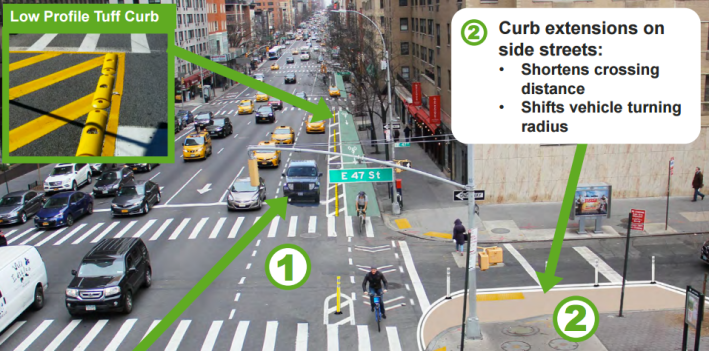
DOT has a plan for a protected bike lane on 16 blocks of Second Avenue that will test out a new configuration, where the only protection is a row of short, yellow plastic "tuff curbs." The project shrinks the protected bike lane gap on the avenue in Midtown but still exposes cyclists to fast-moving motor vehicles on the heavily-trafficked approach to the Queens Midtown Tunnel. DOT presented the plan last night to the Manhattan Community Board 6 transportation committee, which endorsed it with one abstention and no votes against.
The project calls for a bike lane between 59th Street and 43rd Street [PDF], leaving several blocks approaching the Queens Midtown Tunnel with no changes. Between 59th and 52nd Street, the bike lane would be protected with parked cars. But from 52nd Street to 43rd Street the protection afforded by a parking lane will not be in effect during peak hours.
From 7 a.m. to 10 a.m. parking and commercial loading zones will give way to motor vehicle traffic along that nine block stretch. Additionally, between 48th Street and 43rd Street, there will be moving traffic next to the bike lane from 3 p.m. to 7 p.m. To deter motorists from entering the bike lane along those blocks, DOT plans to install "low profile tuff curbs" -- yellow plastic bumps.
Since 2010, motorists have killed one cyclist and four pedestrians in the project area, including 79-year-old Teresa Martinelli, who was killed at 58th Street just last week.
The absence of round-the-clock parking lanes will weaken pedestrian safety measures as well. The parking protected section will have pedestrian islands and dedicated turn signals at some intersections, so pedestrians and turning drivers don't have simultaneous "go" signals. Below 52nd Street, the rush hour lane traffic lanes preclude those measures. Instead, the plan calls for painted curb extensions on side streets to induce motorists to make tighter, safer turns (see above).

The transportation committee endorsed the plan with a request that the city continue to study a continuous protected bike lane for Second Avenue. Still, committee members did not hold back criticism of DOT's unwillingness to address the remaining gaps.
"It doesn't seem to make sense to not have a protected bike lane the whole time," said committee member Kathleen Kelly. "As a rider myself [I'm] thinking: so that means, still, I'm going to need to stay off [this] street, because those little yellow plastic things are not going to stop people who are new to the city or don't understand them.'"
Committee member Larry Scheyer was concerned about the area around the Queens-Midtown Tunnel entrance at 36th Street. "That's where you're going to have to make the tough decision about protecting cyclists and protecting pedestrians and making that the priority over backing up vehicles," he said. "And I think the decision is going to have to come out in favor of safety."
DOT's Patrick Kennedy and Ted Wright gave no commitment to filling in the remaining gaps, saying the agency has been "talking a little bit about it." The agency clearly considers the intense traffic on this part of Second Avenue a limiting factor as it phases in a redesign.
"It's like toothpaste, you have to start at the bottom of the tube and squeeze up to the top," Kennedy explained, referring the traffic around the tunnel. "As much as we want to start at the top, to do that would cause us all sorts of problems. If we were to do something, where we start at a chokepoint, essentially, just from a traffic throughput and network standpoint, that's where any kind of effect you're going to cause to the roadway is going to be amplified significantly."
A design created with a safe, connected bike network as the top priority would look different. "You're funneling people into the most dangerous portion of the corridor, which is insane," one person who came to testify told the DOT reps. "It's irresponsible if you're leading people to these spots and you're not getting them through."





